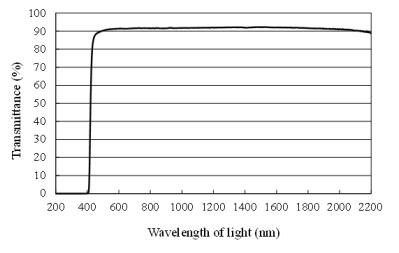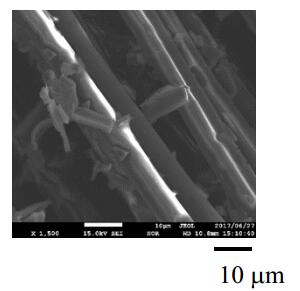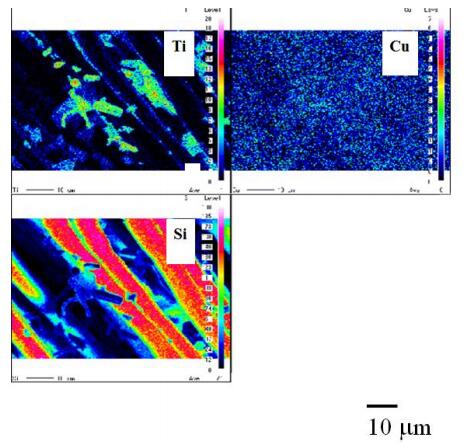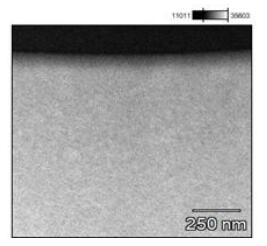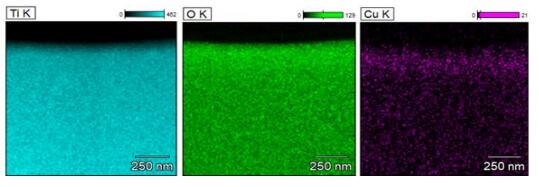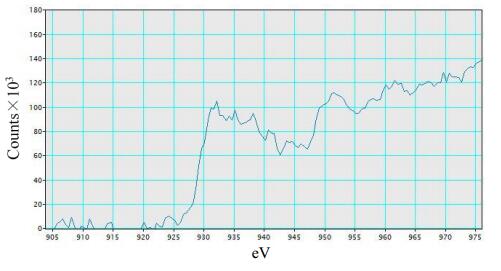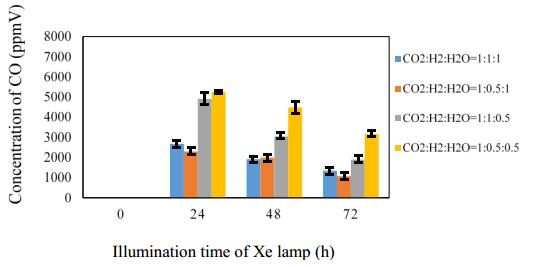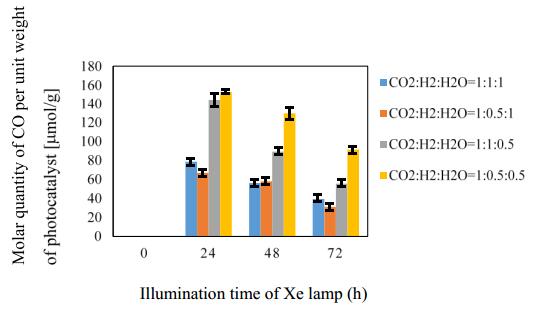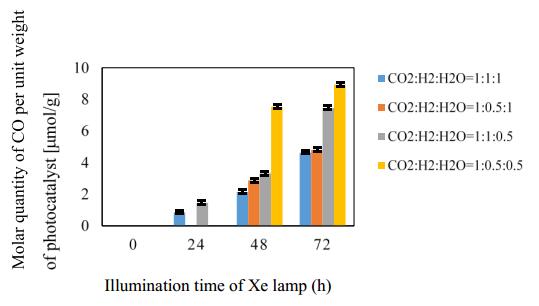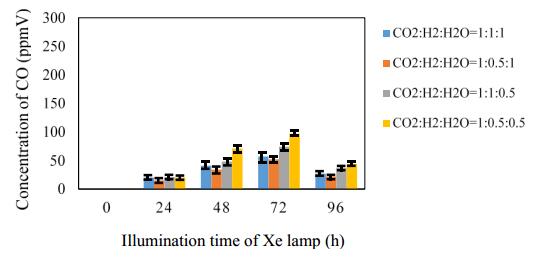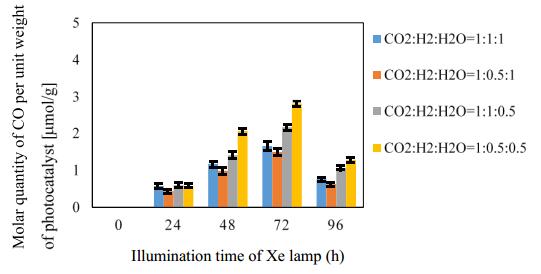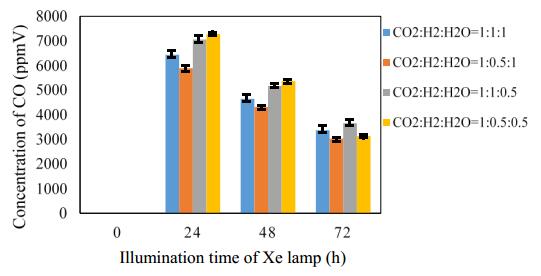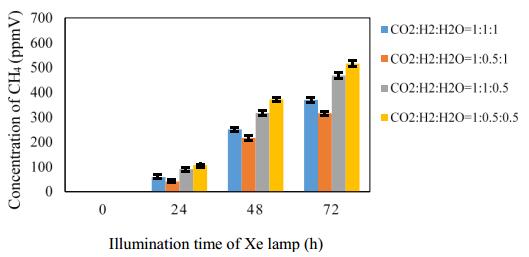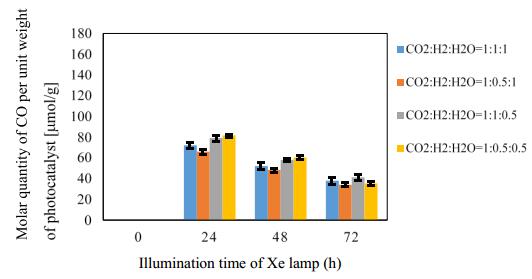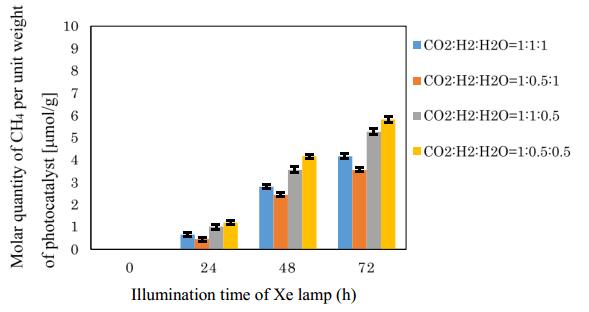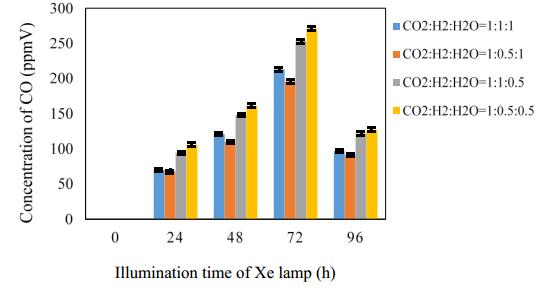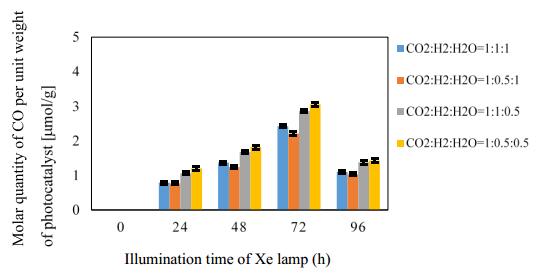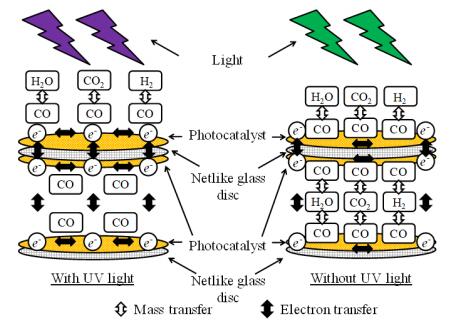1.
Introduction
Due to mass consumption of fossil fuels, global warming and fossil fuels depletion have become serious global environmental problems in the world. After the industrial revolution, the averaged concentration of CO2 in the world has been increased from 278 ppmV to 403 ppmV by 2016 [1]. Therefore, it is necessary to develop a new CO2 reduction or utilization technology in order to recycle CO2.
The application of CO2 as a raw material in order to produce chemicals and energy compromises a way to diminish the CO2 accumulation in the atmosphere [2]. If we consider energy producing possibilities, one possibility is the photochemical conversion of CO2 into value-added chemicals which could be used as fuel [3].
The most widely used photocatalyst for the photocatalytic reactions is TiO2 due to its availability, chemical stability, low cost and resistance to corrosion [4]. It is well known that CO2 can be reduced into fuels, e.g., CO, CH4, CH3OH and H2 etc. by using TiO2 as the photocatalyst under ultraviolet (UV) light illumination [5,6,7,8]. However, pure TiO2 has the limitation. It is only active when irradiated by UV light, which is not effective under sunlight. Since the solar spectrum only consists of about 4% of UV light, sunlight is not able to active the TiO2 effectively for photocatalystic reaction. In addition, TiO2 has a high electron/hole pair recombination rate compared to the rate of chemical interaction with the adsorbed species for redox reactions [9].
Recently, studies on CO2 photochemical reduction by TiO2 have been carried out from the viewpoint of performance promotion by extending absorption wavelength towards visible region. It was reported that a transition metals doping is useful technique for extending the absorbance of TiO2 into the visible region [10,11,12,13,14]. Noble metal doping such as Pt, Pd, Au and Ag [11], Au, Pd-three dimensionally ordered macroporous TiO2 [12], composition materials formed by GaP and TiO2 [13], nanocomposite CdS/TiO2 combining two different band gap photocatalyst [14], carbon-based AgBr nanocomposited TiO2 [15], have been attempted to overcome the shortcomings of the pure TiO2. They could improve the CO2 reduction performance, however, the concentrations in the products achieved in all the attempts so far were still low, ranging from 1 to 150 μmol/g-cat [11,12,13,14,15].
Though various metals have been used for doping [10,11,12,13,14,15], Cu is considered as a favorite candidate. Cu can extend the absorption band to 600–800 nm [16,17], which covers the whole visible light range. Cu-decorated TiO2 nanorod thin film performed ten times yields as large as TiO2 for C2H5OH production [18]. Cu loaded N/TiO2 also showed the good performance which yielded eight times as large as TiO2 for CH4 production [19]. Even under UV light illumination condition, Cu-decorated TiO2 nanorod film yielded ten times as large as TiO2 for CH4 production [20]. Noble metals such as Pt and Au are too expensive to be used in industrial scale. Therefore, Cu is the best candidate because of its high efficiency and low cost compared to noble metals. Due to its availability as well as above described characteristics, Cu is selected as the dopant in this study.
Since a reductant is necessary for CO2 reduction to produce fuel, H2O and H2 are usually used as reductants according to the review papers [6,8]. To promote the CO2 reduction performance of photocatalyst, it is important to select the optimum reductant which provides the proton (H+) for the reduction reaction. The reaction scheme of CO2 reduction with H2O is as follows [21,22,23]:
<Photocatalytic reaction>
<Oxidization>
<Reduction>
The reaction scheme of CO2 reduction with H2 is as follows [24]:
<Photocatalytic reaction>
<Oxidization>
<Reduction>
There are some reports on CO2 reduction with either H2O or H2 [6,8]. However, the effect of using H2O and H2 together as reductants is not investigated well. Though a few studies using pure TiO2 under CO2/H2/H2O condition were reported [24,25,26], the effect of ratio of CO2, H2 and H2O as well as the effect of Cu doping with TiO2 on CO2 reduction performance of photocatalyst was not investigated previously.
In this paper, TiO2 film is coated by combination of sol-gel and dip-coating process on netlike glass fiber (SILIGLASS U, Nihonmuki Co.). After the netlike glass fiber is dipped into TiO2 sol solution, it is dried out and fired in the electric furnace. The netlike glass fiber is a net composed of glass fiber whose diameter is about 10 μm. The fine glass fibers are knitted, resulting that the diameter of agammaegate fiber is about 1 mm. According to manufacture specifications of netlike glass fiber, the porous diameter of glass fiber is about 1 nm and the specific surface area is about 400 m2/g. The netlike glass fiber consists of SiO2 whose purity is over 96 wt%. The aperture of net is about 2 mm × 2 mm. Since the netlike glass fiber has a porous characteristics, it is believed that TiO2 film is captured by netlike glass fiber easily during dipping into TiO2 sol solution. In addition, it can be expected that a CO2 absorption performance of prepared photocatalyst is promoted due to the porous structure of netlike glass fiber.
Then, Cu is loaded on the TiO2 coated netlike glass fiber by pulse arc plasma method which can emit nanosized Cu particles by applying high electrical potential difference. The amount of loaded Cu can be controlled by the pulse number. In the present study, the pulse number is set at 100.
In the present paper, Cu/TiO2 prepared was characterized by Scanning Electron Microscope (SEM) and Electron Probe Micro Analyzer (EPMA), Transmission Electron Microscope (TEM), Energy Dispersive X-ray Spectrometry (EDX) and Electron Energy Loss Spectrum (EELS) analysis. The CO2 reduction performance with H2 and H2O under the condition of illuminating Xe lamp with or without UV light was investigated. The molar ratio of CO2/H2/H2O was changed for 1:1:1, 1:0.5:1, 1:1:0.5, 1:0.5:0.5 to clarify the optimum combination of CO2/H2/H2O for CO2 reduction with Cu/TiO2. In addition, the effect of overlapping two layers of Cu/TiO2 coated netlike glass fiber on CO2 reduction performance was investigated.
2.
Experiment
2.1. Preparation of Cu/TiO2 film
The combination of sol-gel and dip-coating process was used for preparing TiO2 film. TiO2 sol solution was made by mixing [(CH3)2CHO]4Ti (purity of 95 wt%, Nacalai Tesque Co.) of 0.3 mol, anhydrous C2H5OH (purity of 99.5 wt%, Nacalai Tesque Co.) of 2.4 mol, distilled water of 0.3 mol, and HCl (purity of 35 wt%, Nacalai Tesque Co.) of 0.07 mol. Netlike glass fiber was cut to disc, and its diameter and thickness were 50 mm and 1 mm, respectively. The netlike glass fiber disc was dipped into TiO2 sol solution at the speed of 1.5 mm/s and pulled up at the fixed speed of 0.22 mm/s. Then, it was dried out and fired under the controlled firing temperature (FT) and firing duration time (FD), resulting that TiO2 film was fastened on the netlike glass fiber. FT and FD were set at 623 K and 180 s, respectively. Cu was loaded on TiO2 film by pulse arc plasma method. The pulse arc plasma gun device (ULVAC, Inc., ARL-300) having Cu electrode whose diameter was 10 mm was applied for Cu loading. After the netlike glass fiber coated with TiO2 was set in chamber of the pulse arc plasma gun device which was vacuumed, the nanosized Cu particles were emitted from Cu electrode with applying the electrical potential difference of 200 V. The pulse arc plasma gun can evaporate Cu particle over the target in the circle area whose diameter is 100 mm when the distance between Cu electrode and the target is 160 mm. Since the difference between Cu electrode and TiO2 film was 150 nm in the present study, Cu particle can be evaporated over TiO2 film uniformly. The amount of loaded Cu was controlled by the pulse number. In the present paper, the pulse number was set at 100. Since the netlike glass fiber is transparent, the light can pass through the netlike glass fiber. The present study has also investigated if two layers of two Cu/TiO2 coated on netlike glass fiber put on the top of the other (with certain distance, i.e., overlapping), what impact/improvement would be on the CO2 reduction performance. The overlapping two layers of Cu/TiO2 coated netlike glass fiber is expected to utilize the light effectively as well as to increase the amount of photocatalyst used for CO2 reduction.
2.2. Characterization of Cu/TiO2 film
The structure and crystallization characteristics of Cu/TiO2 film were evaluated by SEM (JXS-8530F, JEOL Ltd.), EPMA (JXA-8530F, JEOL Ltd.), TEM (JEM-2100/HK, JEOL Ltd.), EDX (JEM-2100F/HK, JEOL Ltd.) and EELS (JEM-ARM2007 Cold, JEOL Ltd.). Since these measurement instruments use electron for analysis, the sample should be an electron conductor. Since netlike glass disc was not an electron conductor, the carbon vapor deposition was conducted by the dedicated device (JEE-420, JEOL Ltd.) for Cu/TiO2 coated on netlike glass disc before analysis. The thickness of carbon deposited on sample was approximately 20–30 nm.
The electron probe emits the electrons to the sample under the acceleration voltage of 15 kV and the current of 3.0 × 10−8 A, when the surface structure of sample is analyzed by SEM. The characteristic X-ray is detected by EPMA at the same time, resulting that the concentration of chemical element is analyzed according to the relationship between the characteristic X-ray energy and the atomic number. The spatial resolution of SEM and EPMA is 10 μm. The EPMA analysis helps not only to understand the coating state of prepared photocatalyst but also to measure the amount of doped metal within TiO2 film on the base material.
The electron probe emits the electron to the sample under the acceleration voltage of 200 kV, when the inner structure of sample is analyzed by TEM. The size, thickness and structure of loaded Cu were evaluated. The characteristics X-ray is detected by EDX at the same time, resulting that the concentration distribution of chemical element toward thickness direction of the sample is analyzed. In the present paper, the concentration distribution of Ti and Cu were analyzed.
EELS can be applied not only for detecting elements but also determination of oxidation states of some transition metals. The EELS characterization was performed by JEM-ARM200F equipped with GIF Quantum having 2048 ch. The dispersion of 0.5 eV/ch can be achieved for the full width at half maximum of the zero loss peak.
2.3. CO2 reduction experiment
Figure 1 shows that experimental set-up of the reactor consisting of stainless pipe (100 mm (H.) × 50 mm (I.D.)), a netlike glass disc coated with Cu/TiO2 film (50 mm (D.) × 1 mm (t.)) which is located on the teflon cylinder (50 mm (H.) × 50 mm (D.)), a quartz glass disc (84 mm (D.) × 10 mm (t.)), a sharp cut filter which cuts off the light of wavelength below 400 nm (SCF-49.5C-42L, SIGMA KOKI CO. LTD.), a 150 W Xe lamp (L2175, Hamamatsu Photonics K. K.), mass flow controller, CO2 gas cylinder and H2 gas cylinder [27].
The reactor volume available for CO is 1.25 × 10−4 m3. The light of Xe lamp, through the sharp cut filter and the quartz glass disc that are at the top of the stainless pipe, illuminates the netlike glass disc coated with Cu/TiO2 film, which is located inside the stainless pipe. The wavelength of light from Xe lamp is ranged from 185 nm to 2000 nm. The Xe lamp can be fitted with a sharp cut filter to remove UV components of the light. With the filter, the wavelength from Xe lamp is ranged from 401 nm to 2000 nm. Figure 2 shows the light transmittance data of the sharp cut filter to prove the removal of the light whose wavelength is below 400 nm [27]. The average light intensity of Xe lamp on the photocatalyst without and with setting the sharp cut filter is 79.3 mW/cm2 and 67.4 mW/cm2, respectively.
In the CO2 reduction experiment, CO2 gas with the purity of 99.995 vol% and H2 gas with the purity of 99.9999 vol% which were controlled by mass flow controller were mixed in the buffer chamber, and introduced into the reactor which was pre-vacuumed by a vacuum pump. The mixing ratio of CO2 and H2 was confirmed by TCD gas chromatograph (Micro GC CP4900, GL Science) before introducing into the reactor. After confirming the mixing ratio of CO2 and H2, the distilled water was injected into the reactor through a gas sampling tap by syringe and Xe lamp illumination was turned on the same time. The amount of injected water was measured and controlled by the syringe. The injected water vaporized completely in the reactor. The molar ratio of CO2/H2/H2O was set at 1:1:1, 1:0.5:1, 1:1:0.5, 1:0.5:0.5. Due to the heat of Xe lamp, the temperature in reactor was attained at 343 K within an hour and kept at approximately 343 K during the experiment.
The gas in the reactor was sampled every 24 hour during the experiment. The gas samples were analyzed by FID gas chromatograph (GC353B, GL Science) and methanizer (MT221, GL Science). Minimum resolution of FID gas chromatograph and methanizer is 1 ppmV.
3.
Results and discussion
3.1. Characterization of Cu/TiO2 film
Figure 3 shows SEM image of Cu/TiO2 film coated on netlike glass disc. The SEM image was taken at 1500 times magnification. Figure 4 shows EPMA images of Cu/TiO2 film coated on netlike glass disc. EPMA analysis was carried out for SEM images taken by 1500 times magnification. In EPMA image, the concentrations of each element in observation area are indicated by the different colors. Light colors, for example, while, pink, and red indicate that the amount of element is large, while dark colors like black and blue indicate that the amount of element is small.
From these figures, it can be observed that TiO2 film was coated on netlike glass fiber. During firing process, the temperature profile of TiO2 solution adhered on the netlike glass disc was not even due to the different thermal conductivities of Ti and SiO2. Their thermal conductivities of Ti and SiO2 at 600 K are 19.4 W/(m·K) and 1.82 W/(m·K), respectively [28]. Due to the thermal expansion and shrinkage around netlike glass fiber, it can be considered that thermal crack is formed on the TiO2 film.
In addition, it is observed from Figure 4 that nanosized Cu particles are loaded on TiO2 uniformly, resulted from that the pulse arc plasma method can emit nanosized Cu particles.
To evaluate the amount of loaded Cu within TiO2 film quantitatively, the observation area, which is the center of netlike glass disc, of diameter of 300 μm is analyzed by EPMA. The ratio of Cu to Ti is counted by averaging the data obtained in this area. As a result, the weight percentages of elements of Cu and Ti in the Cu/TiO2 film are 0.56 wt% and 99.44 wt%, respectively.
Figures 5 and 6 show TEM and EDX images of Cu/TiO2 film, respectively. EDX analysis was carried out using TEM image taken by 150000 times magnification. According to Figure 6, it is observed that Cu particles are distributed in TiO2 film. Though many Cu particles are loaded on the upside of TiO2 film, it is not confirmed that the Cu layer is formed.
Figure 7 shows EELS spectra of Cu in Cu/TiO2 film. From this figure, the peaks at around 932 eV and 952 eV can be observed. Compared to the report investigating the spectra peaks of Cu, Cu2O and CuO [29], the EELS spectra of Cu2O matches with Figure 7. Therefore, Cu in Cu/TiO2 prepared in this study exists as Cu+ ion in Cu2O. It was reported that the heterojunctions between CuO and TiO2 contributed to the promotion of the photoactivity [30]. In addition, it was reported that Cu+ was more active than Cu2+ [31]. Therefore, it is expected that Cu+ would play a role to enhance the CO2 reduction performance in this study. Figure 8 shows EELS spectra of TiO2 referred from EELS data base [32]. Comparing Figure 8 with Figure 7, EELS spectra of TiO2 is very different from EELS spectra of Cu in Cu/TiO2.
3.2. Effect of molar ratio of CO2, H2 and H2O on CO2 reduction characteristics of Cu/TiO2
Figures 9 and 10 show the concentration changes of CO and CH4 produced in the reactor along the time under the illumination of Xe lamp with UV light on, respectively. Figures 11 and 12 show the molar quantities of CO and CH4 per weight of photocatalyst in the reactor along the time under the illumination of Xe lamp with UV light on, respectively. The amount of Cu/TiO2 is 0.16 g. In this experiment, a blank test, that was running the same experiment without illumination of Xe lamp, had been carried out to set up a reference case. No fuel was produced in the blank test as expected.
According to Figures 9, 10, 11 and 12, the CO2 reduction performance is the highest for the molar ratio of CO2/H2/H2O = 1:0.5:0.5. Since the reaction scheme of CO2/H2/H2O is not fully understood, this study refers to the reaction scheme of CO/H2O and CO2/H2 as shown by Eqs 1–12. It is known from the reaction scheme that the theoretical molar ratio of CO2/H2O and CO2/H2 to produce CO is 1:1. On the other hand, the theoretical molar ratio of CO2/H2O and CO2/H2 to produce CH4 is 1:4. Since the molar ratio of CO2/H2/H2O = 1:0.5:0.5 can be regarded as the molar ratio of CO2/total reductants = 1:1, it is believed that the results of this study follows reaction scheme presented in Eqs 1–12. Comparing the CO production with the CH4 production, CO is produced first. According to Eq 5, it is believed that some CO might be converted into CH4. Therefore, the start of CH4 production is slower than that of CO production. Producing CH4 needs four times H+ and electrons as many as producing CO needs. Therefore, it is revealed that the optimum molar ratio of CO/H2/H2O is decided by the CO production scheme. Though CO decreases after reaching the peak, CH4 increases gradually.
According to Hinojosa-Reyes et al. [33], TiO2 and Cu2O formation leads to the photocatalytic activity since Cu2O is a semiconductor with small band gap energy. In addition, Cu performs to avoid the electron and hole recombination and promote the charge transfer. In this study, it seems that the effect of Cu and Cu2O on photoactivity is performed.
Figures 13 and 14 show the concentration changes of CO produced and the molar quantity of CO per weight of photocatalyst in the reactor under the illumination of Xe lamp without UV light on, respectively. In this experiment, CO is the only fuel produced from the reactions.
According to Figures 13 and 14, the CO2 reduction performance is also the highest for the molar ratio of CO2/H2/H2O = 1:0.5:0.5 in this case. It is considered that the same reaction mechanism as mentioned above is conducted. The CO2 reduction performance of Cu/TiO2 under the illumination condition without UV light is lower than that under the illumination condition with UV light. Therefore, it can be claimed that Cu/TiO2 obtains the main photoenergy from UV light.
3.3. Effect of overlapping on CO2 reduction characteristics of Cu/TiO2
Figures 15 and 16 show the concentration changes of CO and CH4 produced in the reactor under the illumination of Xe lamp with UV light on, with two Cu/TiO2 film coated on netlike glass discs overlapped, respectively. The photocatalyst is coated on both upper and lower surfaces of the top disc and only on the upper surface of the bottom disc.
Figures 17 and 18 show the molar quantities of CO and CH4 per weight of photocatalyst in the reactor along the time under the Xe lamp with UV light on, respectively. The total amount of Cu/TiO2 on two discs is 0.42 g.
According to Figures 15, 16, 17 and 18, the CO2 reduction performance is the highest for the molar ratio of CO2/H2/H2O = 1:0.5:0.5, the same as that in the case of single Cu/TiO2 disc. In addition, the order of CO2 reduction performance of Cu/TiO2 overlapped is the same as that of single Cu/TiO2. However, comparing Figures 15 and 16 with Figures 9 and 10, the concentrations of CO and CH4 for two Cu/TiO2 discs overlapped are higher than those for single Cu/TiO2 disc under every molar ratio of CO2/H2/H2O. The highest concentration of CO for Cu/TiO2 overlapped is 7273 ppmV, which is 1.4 times as large as that for single Cu/TiO2. On the other hand, the highest concentration of CH4 for Cu/TiO2 overlapped is 516 ppmV, which is 1.7 times as large as that for single Cu/TiO2. In the case of two discs overlapped, the following things are believed: (i) The amount of photocatalyst used for photocatalysis reaction is increased, (ii) The electron transfer between two Cu/TiO2 films promotes the activity of photocatalysis reaction, (iii) The lower positioned Cu/TiO2 disc utilizes the light passing through the top disc.
However, comparing Figures 17 and 18 with Figures 11 and 12, the molar quantities of CO and CH4 per weight of photocatalyst in two discs case are lower than those for single Cu/TiO2 disc case under every molar ratio of CO2/H2/H2O. The highest molar quantity of CO per weight of photocatalyst in two discs overlapped case is 82 μmol/g, which is 54% of that in single disc case. Similarly, the highest molar quantity of CH4 per weight of photocatalyst in two discs overlapped case is 5.8 μmol/g, which is 65% of that in single disc case. The reasons of this result are considered to be: (i) Some parts of the Cu/TiO2 film on the lower positioned disc can't receive the light, (ii) If the produced fuel remains in the space between two discs, the reactants of CO2, H2 and H2O would be blocked to reach the surface of photocatalyst, resulting that the photochemical reaction could not be carried out well even though the light is illuminated for photocatalyst.
Figures 19 and 20 show the concentration changes of CO produced and the molar quantity of CO per weight of photocatalyst in the reactor with two overlapped Cu/TiO2 film coated on netlike glass disc under the illumination of Xe lamp without UV light on, respectively. In this experiment, CO is the only produced from the reactions.
According to Figures 19 and 20, the CO2 reduction performance in two discs case is the highest for the molar ratio of CO2/H2/H2O = 1:0.5:0.5 which is the same as that in the single disc case. The order of CO2 reduction performance in two discs case is the same as that in the single disc case. However, comparing Figure 19 with Figure 13, the concentrations in two discs case are higher than those in single case under every molar ratio of CO2/H2/H2O. The highest concentration of CO in two discs case is 271 ppmV, which is 2.8 times as large as that in single disc case. The same reasons explained in the case of illumination with UV light can be thought to cause the results.
In addition, comparing Figure 20 with Figure 14, the molar quantity of CO per weight of photocatalyst in two Cu/TiO2 discs overlapped case is singly higher than that in the single disc case under every molar ratio of CO2/H2/H2O. The highest molar quantity of CO per weight of photocatalyst is 3.1 μmol/g in two discs case, which is 1.1 times as large as that in the single disc case. Though the effect of overlapping layout is not obtained under the illumination condition with UV light, the effect of overlapping layout is confirmed under the illumination condition without UV light. Since the photochemical reaction rate and the amount of produced fuel are small under the no-UV illumination condition compared to that with UV light, it would be beneficial to the mass transfer between produced fuels and reactants of CO2, H2 and H2O on the surface of photocatalyst in no-UV cases [34]. As a result, the mass transfer and photochemical reaction are carried out effectively in no-UV cases. Therefore, the effect of overlapping layout is obtained in no-UV cases. According to the previous reports [35,36], the mass transfer is an inhibition factor to promote the CO2 reduction performance of photocatalyst and it is necessary to control the mass transfer rate to meet the photochemical reaction rate. Figure 21 illustrates the comparison of mass and electron transfer within overlapped two photocatalysts in UV and no-UV illumination cases.
In this study, the highest molar quantity of CO per weight of photocatalyst is 153 μmol/g in a single disc case under the illumination condition with UV light. The CO production performance achieved in this study is approximately 500 times as large as that reported in [24,26] which is owing to Cu doping. The CH4 production performance achieved in this study is almost the same as that reported in [24]. Since the doped Cu provides the free electron preventing recombination of electron and hole produced as well as the improvement of the light absorption effect, the big improvement of CO2 reduction performance is obtained in this study.
One way to further promote the CO2 reduction performance may be that different metals should be doped on the higher and the lower positioned photocatalysts discs. The co-doped such as PbS-Cu/TiO2, Cu-Fe/TiO2, Cu-Ce/TiO2, Cu-Mn/TiO2 and Cu-CdS/TiO2 would promote the CO2 reduction performance of TiO2 under the CO2/H2O condition [6,8]. When the combination of CO2/H2/H2O is considered, the ion number of dopant is important to match the number of electron emitted from the dopant with H+ as shown by the reaction schemes of CO2/H2O and CO2/H2. The same number of electron and H+ is necessary for fuel production. Though Cu+ ion is applied to promote the CO2 reduction performance with TiO2 in this study, it is expected that the co-doping Cu and the other metal having larger positive ion might have positive effect for CO2 reduction with H2 and H2O. In addition, the dopant like Fe, which can absorb the shorter wavelength light than Cu [16,37,38], should be used at the higher positioned layer. The wavelength of light becomes long after penetrating the higher positioned photocatalyst [34]. Therefore, the overlapping of the higher positioned Fe/TiO2 which absorbs the shorter wavelength light and the lower positioned Cu/TiO2 which absorbs the longer wavelength light may be an effective way for utilization of wide range light. This idea is similar to the concept of hybridizing two photocatalysts having different band gaps [13,39,40].
4.
Conclusion
Based on the investigation in this study, the following conclusions can be drawn:
(ⅰ) Cu in Cu/TiO2 prepared by this study exists in the form of Cu+ ion in Cu2O.
(ⅱ) The highest concentrations of CO and CH4 produced as well as the highest molar quantities of CO and CH4 per weight of photocatalyst for Cu/TiO2 are obtained for CO2/H2/H2O ratio of 1:0.5:0.5. Since the molar ratio of CO2/H2/H2O = 1:0.5:0.5 can be regarded as the molar ratio of CO2/total reductants = 1:1, it is believed that the results of this study follow reaction schemes of CO2/H2O and CO2/H2.
(ⅲ) Under the illumination condition with UV light, the highest concentration of CO in two discs case is 1.4 times as large as that in the single disc case, while the highest concentration of CH4 is 1.7 times. Under the illumination condition without UV light, the highest concentration of CO with two Cu/TiO2 discs is 2.8 times as large as that with single Cu/TiO2 disc.
(ⅳ) Under the illumination condition with UV light, the highest molar quantity of CO per weight of photocatalyst with two Cu/TiO2 discs overlapped is 54% of that with single Cu/TiO2 disc. The highest molar quantity of CH4 per weight of photocatalyst with two Cu/TiO2 discs overlapped is 65% of that with single Cu/TiO2 disc.
(ⅴ) Under the illumination condition without UV light, the molar quantity of CO per weight of photocatalyst with two Cu/TiO2 discs overlapped is slightly (1.1 times) higher than that with single Cu/TiO2 disc.
Acknowledgments
The authors would like to gratefully thank from JSPS KAKENHI Grant Number 16K06970, and joint research program of the Institute of Materials and Systems for Sustainability, Nagoya University for the financial support of this work.
Conflict of interest
The authors declare that there is no conflict of interest regarding the publication of this paper.










 DownLoad:
DownLoad:
